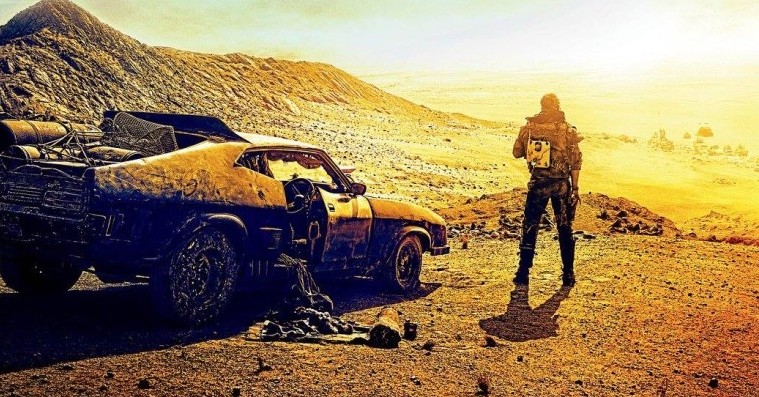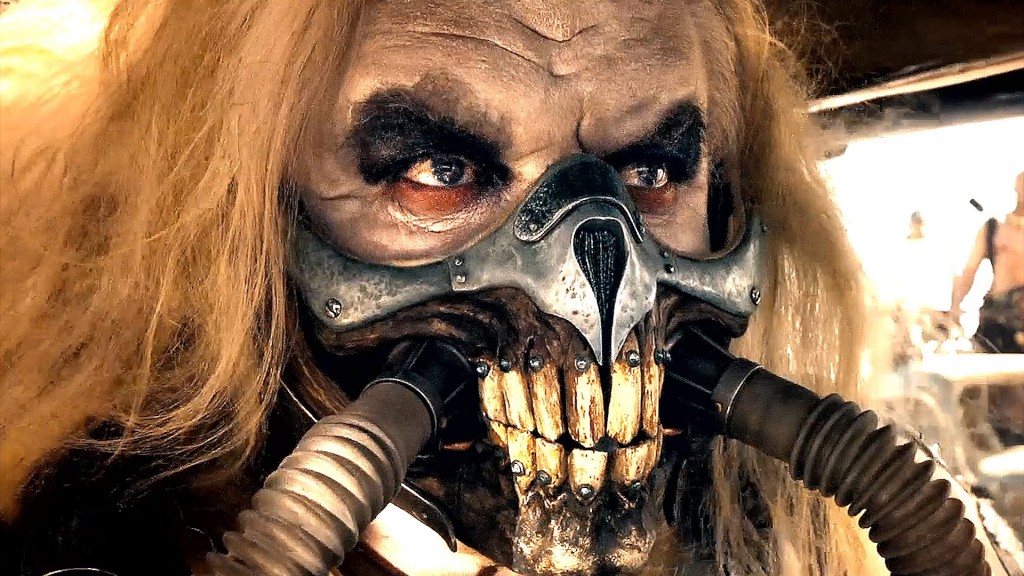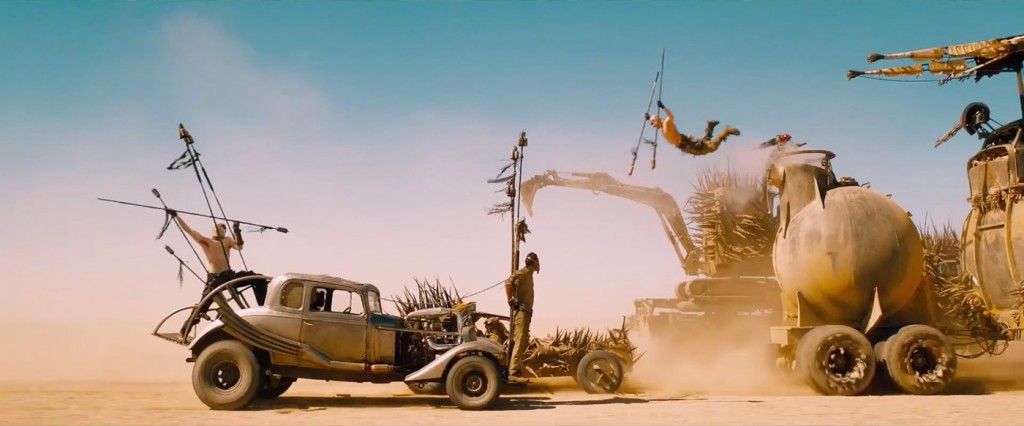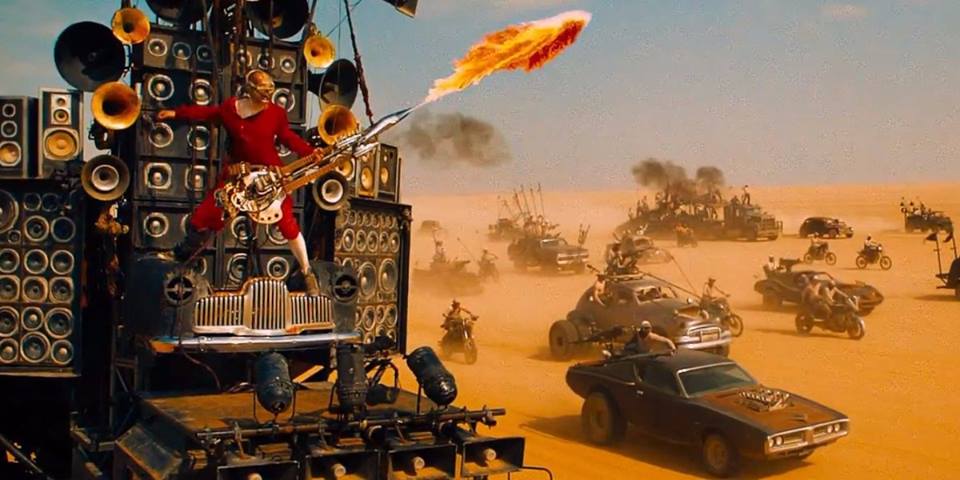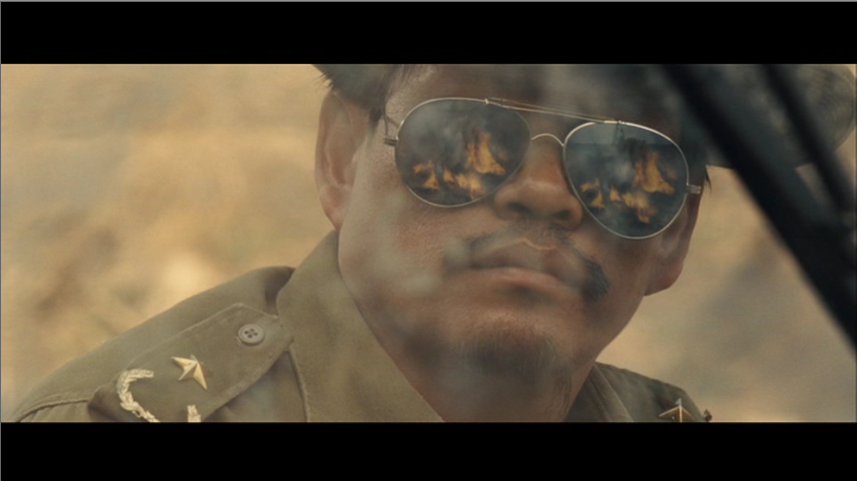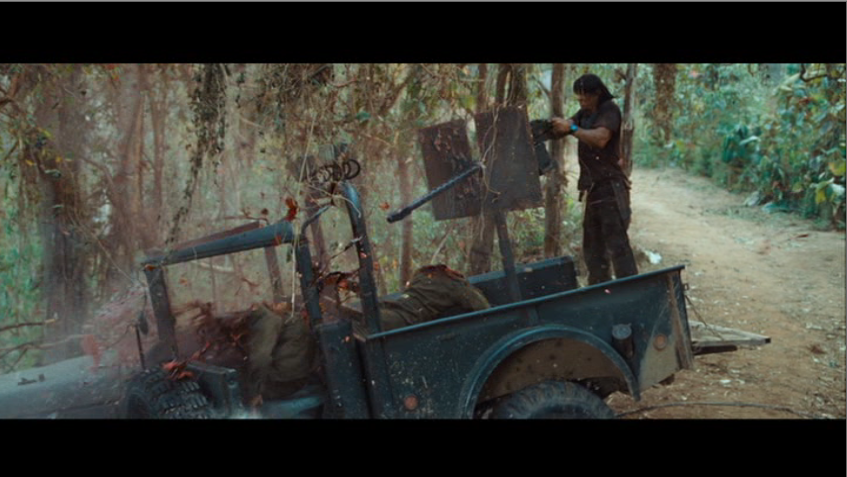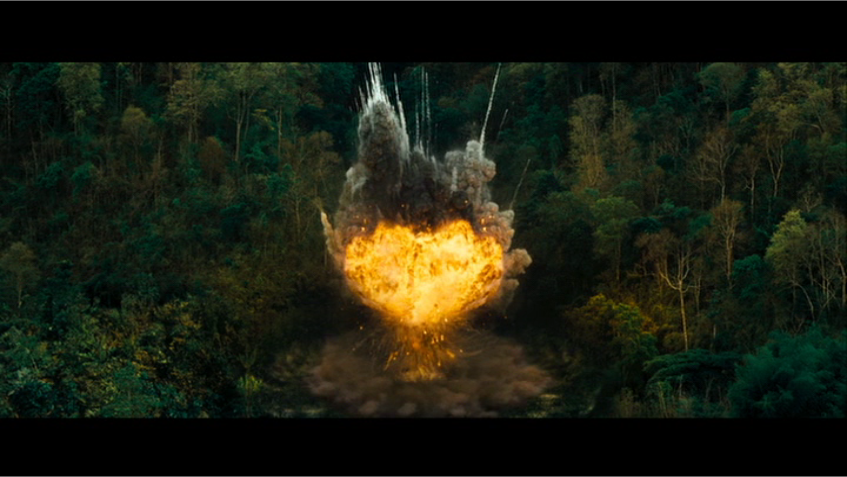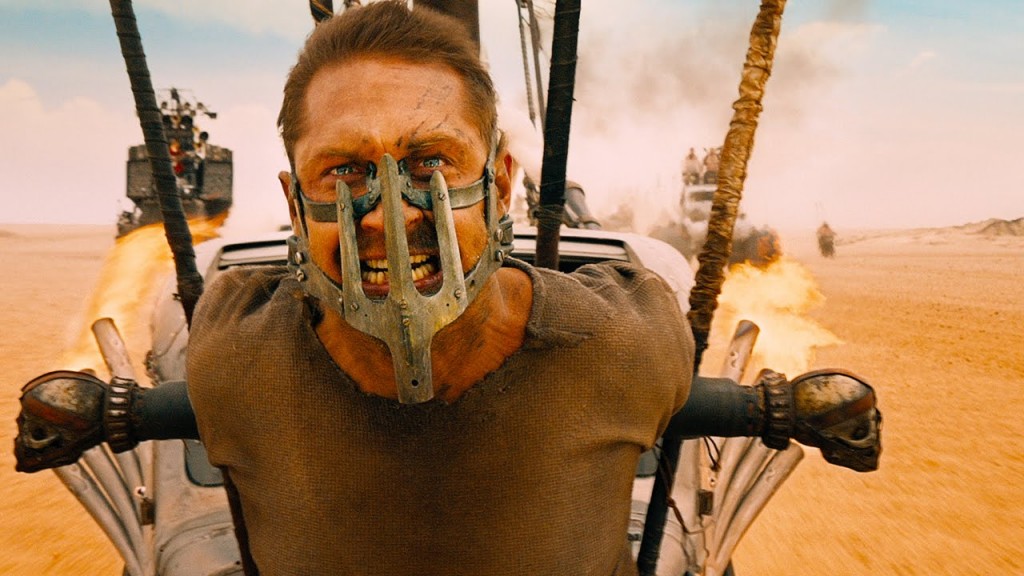Written By Zak Attack
Well here we are. The final showdown. Let’s take a look at how the opponents have fared so far…
Mad Max: 1 ½ – First Blood: 3 ½… WINNER: First Blood
The Road Warrior: 3 ½– Rambo: First Blood Part II: 1 ½… WINNER: The Road Warrior
Mad Max Beyond Thunderdome: 2 ½ – Rambo III: 2 ½… WINNER (by a nose): Mad Max Beyond Thunderdome
So while “Mad” Max Rockatansky is up 2-1 on rounds, we’re all tied up on points at 7 ½. Nice! It wasn’t even planned this way, so it’s quite exciting that this came down to a nail-biter finish. Now it’s time for two long-awaited sequels (Rambo came 20 years after Rambo III, while Mad Max: Fury Road came a whopping 30 years after Mad Max Beyond Thunderdome) where the filmmakers decided to zig where another series may have zagged. Instead of making a self-referential reboot or using modern technology to go a wild action-adventure route, both George Miller and Rambo director Sylvester Stallone opted for a bare bones story on which to hang a spectacle of visually unique action.
The Tale of the Tape:
The Summary:
Mad Max: Fury Road starts as our favorite post-Apocalyptic drifter (Tom Hardy replacing Mel Gibson) gets captured by the people of The Citadel, a desert stronghold where a despotic leader named Immortan Joe (original Mad Max villain, Hugh Keays-Byrne) rules over a loyal and downtrodden community. Max has been earmarked as a blood bag for a soldier of Joe’s named Nux (Nicholas Hoult). It’s not quite clear why these pale-skinned soldiers (dubbed “War Boys”) need a blood bag to sustain their violent lust, but Miller treats expository information the same way the rictus-grinned Joe treats his peoples’ access to vital resources… doling it out in paltry increments as he sees fit. (“Do not, my friends, become addicted to water. It will take hold of you and you will resent its absence.”)
When one of Joe’s generals, Imperator Furiosa (a one-armed Charlize Theron), rebels by turning a routine supply run into an escape for Immortan Joe’s brides (read: sex slaves) the War Boys take chase with blood bags in tow. In the chaotic action setpiece, Max finds himself free of his chains and forms a precipitous, yet symbiotic partnership with Furiosa to help the entire group get to a safe place away from those who would have them dead and/or enslaved. After the safe place is found to be destroyed, Furiosa, Max, the brides, and a group of gun-toting octogenarian woman called “The Vulvalini” (“The Golden Girls” was already taken) hilariously decide to basically play the preceding run of film in reverse and head right back to The Citadel. More explosions, controlled chaos, and toe-curling stunts ensue.
Rambo is, shockingly, an even simpler film than Mad Max: Fury Road. Professional murderer of foreigners, John Rambo (Sylvester Stallone… of course) now lives as a quiet snake wrangler in Thailand, mostly keeping to himself and trying to maintain the level of peace he enjoyed at the beginning of Rambo III.
When a group of missionaries arrive in his neck of the woods, they try to hire out Rambo’s boat so they can go to Burma and provide aid to a village of tribespeople constantly under the threat of murder from Tatmadaw soldiers. He is initially reluctant to get involved in any sort of conflict, but when one of the missionaries (Julie Benz) makes an impassioned argument about how saving others is worth the risk, Rambo relents.
They eventually arrive, but immediately after Rambo drops them off and leaves, the missionaries are kidnapped by the ruthless bad guys. They’re so ruthless, in fact, that their introduction involves forcing some innocent villagers to race across a minefield. The villains end up killing the few that don’t explode in the process anyway.
Rambo is hired to escort a group of mercenaries to the place where he dropped off the now captives. After the mercs discount him as simply a washed-up boatman, he reflects on Julie Benz’s words and decides to participate in the rescue and kill a whole bunch of people in the process.
The Competition:
Category 1 – The People Who Get Paid to Talk:
Rambo has fine acting, I guess. Sylvester Stallone literally looks like his face is (poorly) chiseled out of granite, but still manages a sadness in his eyes that works quite well. There are long stretches of Rambo giving people the silent treatment, especially the confrontational mercenary played by Graham McTavish (who I’m not entirely sure isn’t a live-action Call of Duty character). Stallone does a lot here with a thousand yard stare.
Not all the characters are particularly fleshed out, but after the complete lack of nuance in Rambo: First Blood Part II and Rambo III, it’s refreshing to see some emphasis on the performances in the first act. The original First Blood is still the high water mark when it comes to providing emotional resonance with the characters, but Rambo is perfectly adequate. This is especially true considering the “type” of movie it is, but we’ll get into that once we start talking about the depiction of gory violence.
On the other hand, Mad Max: Fury Road stars Oscar-winner Charlize Theron and critical darling Tom Hardy. They would really have to screw this one up to lose the battle. Thankfully, they don’t. Much has been said of what Hardy does without a whole lot of dialogue, but it really has to be seen to be believed. Through simply his body language, Hardy’s able to paradoxically imbue Max with confusion and assuredness, sensitivity and hulking anger, compassion and naked self-interest. This latter combination is key to believing the complicated and fruitful partnership between Max and Theron’s Furiosa.
By the first weekend, there were already too many thinkpieces about Mad Max: Fury Road‘s status as a feminist screed. And while it does literally have a group of woman taking down a patriarchal society while shouting “We are not things!”, the true wonder is in Charlize Theron’s great performance. Miller’s script is pretty straightforward, so it’s up to the actors to get across a lot of the subtext. Despite being such a capable and powerful woman, the true strength of Furiosa’s character can be seen in how Theron shows her vulnerability. Luckily, the film gives her ample time to do that without sacrificing any time from the electrifying chase sequences.
I should also mention that Rosie Huntington-Whitely gives a career-making performance as the pregnant bride of Joe. “Career-making” for me, because I’d previously known her simply as the Victoria’s Secret Angel turned Michael Bay ingenue. And although all of his dialogue is recorded through a mask, I could listen to Hugh Keays-Byrne shout “Mediocre!” all day.
SCORE: Mad Max: Fury Road: 1 – Rambo: 0
Category 2 – What they Get Paid to Say:
As I rewatched both these quadrilogies, the thing that really stood out to me as how economical a filmmaker George Miller is. He does so much with cinematic language, it really makes you realize how much time is wasted in other movies with boring exposition.
Even ignoring the awesome scale of the action, Mad Max: Fury Road is Miller’s most ambitious movie to date. The world has an exceptionally complicated mythology as we’re quickly shown the brides’ chastity belts, a room where Joe literally drains the milk from women’s breasts, a religion that regularly mentions Valhalla, a trade agreement between Bullet Farm and Gas Town, a metallic spray that is applied directly to the mouth right before suicide, and, of course, a musical flame thrower-playing “Doof Warrior”. All of these things are shown visually and in offhanded comments without explanation, and it’s an absolutely brilliant decision because Miller trusts the audience to figure out all these secondary (and even tertiary) details to his completely batty world.
Rambo also benefits from a dearth of exposition in its straightforward story. However, it alternately suffers from some really on-the-nose didactic arguments and ham-fisted politics. Each Rambo movie has had an incredibly obvious actionable message. First Blood‘s focus on the treatment of veterans was incredibly timely and well-communicated, but as the films went on the messages became less universal and more ethically charged. In Rambo, the surface-level thesis is that the humans rights violations in Burma need to stop. This is noble and all, but by portraying the villains as animalistic rapists, pedophiles, and callously thrill-seeking murderers who barely have faces, this message tends to get a little lost.
Meanwhile, Rambo is unique among the four movies by having its characters discuss why we need to act on its political motive throughout the entire film. The other movies at least waited until a concluding monologue at the end to wear the actionable proposition on its sleeve.
SCORE: Mad Max: Fury Road: 2 – Rambo: 0
Category 3 – A Place in the Franchise: Genre Classification
It seems silly to point out that Rambo doesn’t fit the formula of the other movies, but a glaring omission was the obligatory scene where John Rambo stealthily dispatches a group of villains trying to take him down. A heavy-handed political point, some explosions, an ill-fitting ballad, and a scene where Rambo quietly sneaks around with his knife are throughlines for the other three films. This fourth movie just has him ripping bad guys in half with a .50 caliber aircraft gun on the back of a truck. It’s probably the least stealthy way he could go about doing anything.
By replacing the lead actor, Mad Max: Fury Road holds an especially unique place in the series. It’s a reboot/sequel/prequel/spin-off/whatever. George Miller has always played pretty fast and loose with the continuity of the world though, so this fourth entry fits just right amongst the others. It’s a post-apocalyptic myth where a guy named Max helps some people overthrow oppressive social contracts… that’s pretty much what every sequel to Mad Max has been so far.
But really, let’s just get it out of the way: Mad Max: Fury Road is near perfect. It’s almost a miracle how seamlessly it feels like the other Mad Max films while still incorporating stylistic choices that are indicative of modern action filmmaking. The way it truly stands out, in fact, is its explicit focus on deeper themes about survival, loss, and class-based exploitation judiciously sprinkled throughout the jaw-dropping action.
SCORE: Mad Max: Fury Road: 3 – Rambo: 0
Category 4 – Action A Go Go
Rambo takes an interesting path for such an indulgent, go-for-broke action series by depicting its violence as grim and completely unappealing as possible. There are none of the lovingly photographed fireballs of the previous films. It’s rainy, muddy, bloody chaos on the Burmese landscape.
Rambo is also the first movie that really comments on its violence as a morally ambiguous conundrum. John Rambo believes that horrific violence can only be combated with the vicious cycle of more violence (echoing his quote from Rambo: First Blood Part II, “To survive war, you have to become war”) except he’s also given up that there is any solution to the atrocities of the world. To Rambo, violence is a both a universal constant and a self-fulfilling prophecy. He’s the ultimate nihilist at the beginning of the film. When he uses an undetonated tallboy bomb that was dropped by the British (a symbol of foreign interventionism) to decimate an entire forest area, the metaphor is clear.
When one of the (excessively preachy) non-violent missionaries resorts to bashing in the head of one of his captors, there is nothing cathartic about it. In the other Rambo films there is an undercurrent of revenge to the proceedings, but here everything is equally thrilling and disgusting.
Although let me get sidetracked here to bring up one personal moment of catharsis. I may be misremembering this, but I was watching an episode of The Golden Girls when I was a kid and remembered a scene where Dorothy had to track down a troubled youth in a movie theatre where he was watching a Rambo film. “Oh, is this the scene where he rips out the guy’s throat,” she asks… cue the bloodcurdling sound effect. At that point I’d still never seen Road House, so the possibility of witnessing an honest-to-goodness throat rip onscreen was super exciting. But apparently the writers of the beloved sitcom were taking some artistic liberties because when I got around to familiarizing myself with Rambo’s oeuvre, there wasn’t a throat rip to be found. It wasn’t until this fourth movie decades later that I finally got to see John Rambo plunge his fingers into a guy’s neck and rip out a voicebox.
And that’s the story of how I snuck in two separate references to The Golden Girls on a website called Action A Go Go.
The most striking part of the action in this 2008 outing is the computer generated gore. While it’s distracting and silly, there’s something slightly artistic about the otherworldly splash of red across a screen as if John Rambo’s just skulking around an arcade and playing Maximum Force. Or as a buddy of mine described it: “All I remember about that movie is that every death looks like someone popped a water balloon full of Kool-Aid.” Ultimately, it doesn’t work for the film though.
It’s hard to compare a movie with some of the ugliest bloodshed with a movie that has some of the most dazzling mayhem to appear on celluloid. Mad Max: Fury Road is defined by a singularly artistic voice working to craft aesthetically dynamic rampages of “fire and blood”. Don’t get me wrong, the violence here has clear consequences, but it’s also viscerally fun and upsettingly beautiful.
It’s a wonder that this hyperkinetic and deceptively messy film feels so lovingly fussed over. Explosions are color-corrected to crimson red against the light blue sky and slowed down as if to look like blood seeping into the sea. Characters of countless different designs become mangled into an orgiastic frenzy of action. The camera speeds up and slows down seemingly at will to provide the most effective view of whatever wild setpiece is being placed into that gorgeously rendered frame.
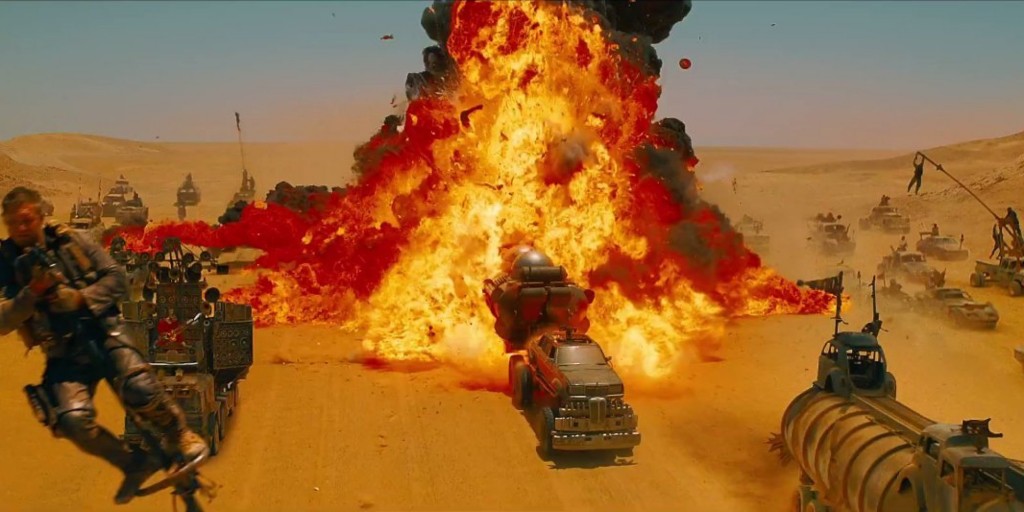
Such care is put into the absurd and ridiculous that the only appropriate reaction is to gasp, scream, and laugh. From the production design to the stunts to the editing, Mad Max: Fury Road is an action masterpiece.
SCORE: Mad Max: Fury Road: 4 – Rambo: 0
Well this is anti-climactic. Mathematically, Mad Max: Fury Road came away with it awhile ago… but will it be a complete shut-out?
Category 5 – A Character’s Journey
One thing that Rambo has over Mad Max: Fury Road is consistency in storytelling style and character. We’ve previously praised George Miller for not being a slave to the canon of Max, but with a different actor and little reference to the previous films, Mad Max: Fury Road feels slightly more disjointed. It’s not a fault of the film, but if judging on the criteria of the series as an arc, it’s clear that the films aren’t concerned with such trivial matters.
In casting Tom Hardy, a lot of the baggage from the other films is completely washed away. Max is a wonderful character in this movie, but there is no legacy to the previous films. In a wasteland of over-referential reboots and fan-servicey sequels, it’s exciting to see a movie that is only interested in telling a single story instead of worrying about past, present, and future. However, I set-up these categories, like, weeks ago… so Mad Max: Fury Road fails here.
That being said… the possibilities of character growth for this “new” Max are endless and I think I speak for everyone when I say “Bring on the sequels!”
On the complete opposite end of the spectrum, Rambo literally bookends the series with a final image directly lifted from the beginning of the first film. Clad in a military jacket, a rucksack, and feathered hair, John Rambo is back in the United States in order to connect to someone he hasn’t seen in years. I think it’s the first time he smiled since that opening sequence of First Blood.
Taken as a whole, Rambo gives respect to the mythology of its main character and manages to play with the idea of war and conflict in interesting ways through the years. That final scene is a touching moment for fans of the series and renders all current talks of a Rambo 5 incredibly worrisome. John Rambo’s story is over, and he had a really good run.
The Final Verdict:
SCORE: Mad Max: Fury Road: 4 – Rambo: 1
As of the publishing of this article, the faithful readers of Action A Go Go have had three weekends in which to see Mad Max: Fury Road in the theatre. The question is not, “Have you seen this movie yet?” The question needs to be “How many times have you seen this freakin’ movie?!”
In case you’re a complete failure and still have not seen it, don’t believe the hype of Mad Max: Fury Road. Nay, mere believing is insufficient. Thou must worship at the altar of Mad Max: Fury Road. Unfortunately, the editors of Action A Go Go have spoken and we’ve decided that other action movies are actually being released this year, so we should shut up about “Mad” Max Rockatansky and focus on other things… at least until the Blu-Ray release.
Part 1: Mad Max vs. First Blood
Part 2: The Road Warrior vs. Rambo: First Blood Part II
Part 3: Mad Max Beyond Thunderdome vs. Rambo III
FINAL SCORE:
Mad Max: Winner of 3 rounds with 11 ½ total points across the entire competition – John Rambo: Winner of 1 round with 8 ½ total points
Action A Go Go on Twitter and Instagram | Follow Zak Attack on Twitter and Letterboxd | Be sure to leave your thoughts in the comments section!
Zak has been an avid movie fan since his mom made him cover his eyes before the “icicle stabbing” when they rented Die Hard 2 in 2nd Grade. As a consolation, in 6th grade he got straight A’s so she gave him the entire Die Hard trilogy on VHS. The rest is history.
The views and commentaries expressed on these pages are solely those of their authors and are not necessarily either shared or endorsed by ActionAGoGo.com
All Mad Max: Fury Road images courtesy of Kennedy Miller Mitchell
All Rambo images courtesy of Millennium Films

